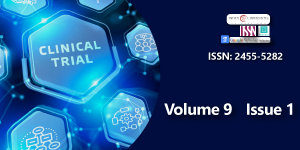Activating dormant strongyloidiasis secondary to COVID-19 treatment
Main Article Content
Abstract
The SARS-CoV-2 pandemic has grown into a major global concern with huge efforts to combat the spread. Exaggerated inflammatory response plays a major role in which was the rationale to use corticosteroids to treat patients. However, multiple studies showed an association between opportunistic and bacterial infections with corticosteroid therapy. We report a case of a 76 year old patient diagnosed with COVID-19 treated with 10 days Dexamethasone and Remdesivir who presented with abdominal symptoms with eosinophilia. Biopsy and stool studies revealed Strongyloides stercoralis larvae. The patient was treated with 2 doses of Ivermectin with significant clinical resolution. Clinician should have high clinical suspicion for Strongloydiasis in patients who have lived or visited endemic areas and for patients with unexplained eosinophilia. Prompt treatment with Ivermectin is crucial for confirmed cases and high risk cases where obtaining a diagnosis is unfeasible.
Downloads
Article Details
Copyright (c) 2022 Alkaabba F, et al.

This work is licensed under a Creative Commons Attribution 4.0 International License.
Rothan HA, Byrareddy SN (2020) The epidemiology and pathogenesis of coronavirus disease (COVID-19) outbreak. J Autoimmun 109: 102433.Link: https://bit.ly/3GhdXlk
Zhang C, Wu Z, Li JW, Zhao H, Wang GQ (2020) Cytokine release syndrome in severe COVID-19: interleukin-6 receptor antagonist tocilizumab may be the key to reduce mortality. Int J Antimicrob Agents 55: 105954. Link: https://bit.ly/3GieP96
Veronese N, Demurtas J, Yang L, Tonelli R, Barbagallo M, et al (2020) Use of corticosteroids in Coronavirus disease 2019 pneumonia: A systematic review of the literature. Front Med (Lausanne) 7. Link: https://bit.ly/35EInkV
Horby P, Lim WS, Emberson JR, Mafham M, Bell JL, et al. (2021) Dexamethasone in hospitalized patients with covid-19. N Engl J Med 384: 693–704. Link: https://bit.ly/3L1vXne
Wang M, Cao R, Zhang L, Yang X, Liu J, et al (2020) Remdesivir and chloroquine effectively inhibit the recently emerged novel coronavirus (2019-nCoV) in vitro. Cell Res 30: 269–271. Link: https://bit.ly/3J9IZ0v
Frost MT, Jimenez-Solem E, Ankarfeldt MZ, Nyeland ME, Andreasen AH, et al. (2020) The Adaptive COVID-19 Treatment Trial-1 (ACTT-1) in a real-world population: a comparative observational study. Crit Care 24: 677. Link: https://bit.ly/3s6qBOZ
Obata R, Maeda T, Rizk D, Kuno T (2021) Increased secondary infection in COVID-19 patients treated with steroids in New York city. Jpn J Infect Dis 74: 307–315. Link: https://bit.ly/3gc4eC2
Klein NC, Go CH-U, Cunha BA (2001) Infections associated with steroid use. Infect Dis Clin North Am 15: 423–432. Link: https://bit.ly/3AO479h
Greaves D, Coggle S, Pollard C, Aliyu SH, Moore EM (2013) Strongyloides stercoralis infection. BMJ 347: f4610. Link: https://bit.ly/347AyUq
Mafort TT, Reis LVT, Faria LF, Pinto BM, Silva RV, et al. (2017) Alveolar hemorrhage secondary to infection by strongyloides stercoralis in immunosuppressed patient—case report. Am J Respir Crit Care Med 195: A5586. Link: https://bit.ly/34bSvRA
Buonfrate D, Requena-Mendez A, Angheben A, Muñoz J, Gobbi F, et al. (2013) Severe strongyloidiasis: a systematic review of case reports. BMC Infect Dis 13: 78. Link: https://bit.ly/3APQvKF
Brotherton H, Usuf E, Nadjm B, Forrest K, Bojang K, et al. (2020) Dexamethasone for COVID-19: data needed from randomised clinical trials in Africa. Lancet Glob Health 8: e1125–e1126. Link: https://bit.ly/3oh9VDs
Mejia R, Nutman TB (2012) Screening, prevention, and treatment for hyperinfection syndrome and disseminated infections caused by Strongyloides stercoralis. Curr Opin Infect Dis 25: 458-463. Link: https://bit.ly/3APQhTP
Kassalik M, Mönkemüller K (2011) Strongyloides stercoralis hyperinfection syndrome and disseminated disease. Gastroenterol Hepatol (N Y) 7: 766-768. Link: https://bit.ly/3ITF9Ix
Requena-Méndez A, Buonfrate D, Gomez-Junyent J, Zammarchi L, Bisoffi Z, et al. (2017) Evidence-based guidelines for screening and management of strongyloidiasis in non-endemic countries. Am J Trop Med Hyg 97: 645–652. Link: https://bit.ly/3gdKs9t
Stauffer WM, Alpern JD, Walker PF (2020) COVID-19 and dexamethasone: A potential strategy to avoid steroid-related Strongyloides hyperinfection: A potential strategy to avoid steroid-related Strongyloides hyperinfection. JAMA 324: 623-624. Link: https://bit.ly/3Gbzyvq
Buonfrate D, Salas-Coronas J, Muñoz J, Maruri BT, Rodari P, et al. (2019) Multiple-dose versus single-dose ivermectin for Strongyloides stercoralis infection (Strong Treat 1 to 4): a multicentre, open-label, phase 3, randomised controlled superiority trial. Lancet Infect Dis 19: 1181–1190. Link: https://bit.ly/3IPU4n6
CDC-Centers for Disease Control (2010) Prevention. CDC - Strongyloides - resources for health professionals.
Marchese V, Crosato V, Gulletta M, Castelnuovo F, Cristini G, et al. (2021) Strongyloides infection manifested during immunosuppressive therapy for SARS-CoV-2 pneumonia. Infection 49: 539–542. Link: https://bit.ly/3ulTKsp
Lier AJ, Tuan JJ, Davis MW, Paulson N, McManus D, et al. (2020) Case report: Disseminated strongyloidiasis in a patient with COVID-19. Am J Trop Med Hyg 103: 1590–1592. Link: https://bit.ly/3of2Mn1

